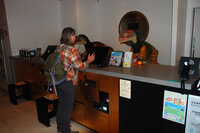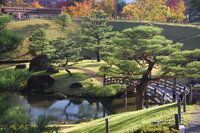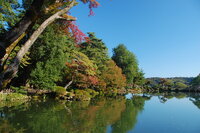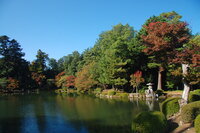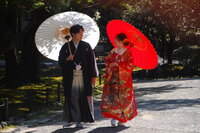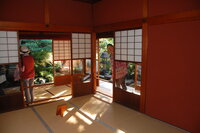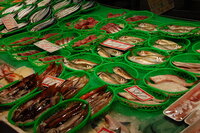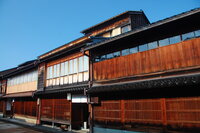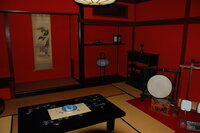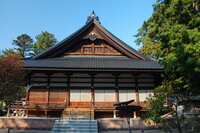Kanazawa
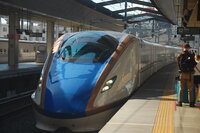
We left Matsumoto with mixed feelings. It's always good to be moving on to a new place but, at the same time, we liked the mountain city and it is certainly in a spectacular location. The hotel looked after us very well and the whole place had a fun, holiday vibe to it - which is generally a winner in anyone's book.
So, we may have said that the Shinkansen from Nagano to Kanazawa made six stops. This misleading
information resulted from Steve's total inability to use the internet. In fact, we only made one
stop. Still, this does not detract from the admirable performance of Kagayaki 509, which zipped us
along at a breezy 150, sometimes touching 160mph. It's not the fastest of the Shinkansen, but Brits
will know why this is a big deal! The carriages are sealed from the outside pressure to avoid
barotrauma when entering tunnels (of which there are many on this route). Needless to say, we didn't
have a lot of time to appreciate the sheer joy of travelling on a clean, quiet, efficient and rapid
service. It is also worth observing that the signage at the stations giving train information does
not seem to have anywhere to display delay time. And, of course, it is absolutely clear exactly
where one has to stand queue to get on one's allocated carriage which arrives
exactly where it should when it should.
Kanazawa is on the northern coast more or less. Whilst we did see the ocean from the train, it won't be forming a significant part of our stay here as the centre of town is quite a way from the coast and that's where the historical interest lies. Locating our hotel was straightforward, which is more than can be said for the check-in process. Dealing with hotel staff in Japan is a little bit of a challenge although most of them speak way better English than our Japanese. The same can not be said for dinosaurs.
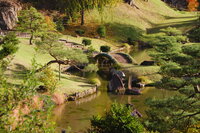
That's right. The front desk at our hotel is staffed by a couple of animatronic dinosaurs. In reality, this gimmick (for that is what it is, no really, it is) doesn't quite work, a fact that's given away by the telephone on the check-in desk for summoning an human. No wonder the dinosaurs became extinct if they can't even check in guests successfully! It actually seemed to generate more work for the staff who were constantly being summoned by bemused guests who were making extraordinary requests of the poor dinosaurs like: "which room am I actually in?"
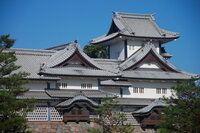
Jurassic check-in complete, we headed out to a local garden. Typically for Japan, the Gyokusen-inmaru park does not consist of a couple of broken swings and a pile of dog crap, rather an immaculately manicured garden and pond that just reeks of Feng Shui. We also visited the Kanazawa castle park. Again, this castle is made of wood, but this time a distinguishing feature is that it is white (as opposed to the black Crow Castle in Matsumoto). It's got some interesting right-angled gateways that were obviously constructed to slow down invaders and trap them in the killing zone.
According to the tourist blurb, Kanazawa is home to one of the three best gardens in Japan. Presumably this means it is the third best; although how such a thing is judged is anyone's guess. Kenroku-en is certainly a nice enough place to stroll around for a couple of hours. There is probably a load of Japanese sophistication to the layout of the place, but to us it's just a nice garden with lakes, fountains, waterfalls, statues, etc. Pretty much, in fact, like our garden at home.
Close by is the 21st Century Museum of Contemporary Art. This place contains a bunch of modern art that we looked at.
Way more interesting was the Naga-machi district. This is the area of town where the Shogun used to live. Here the streets are narrow and winding and full of blind corners where enemies would be caught unawares. It is not clear if there was ever much fighting here but, if you're a Shogun, it probably pays to be on the safe side! Good to be able to see inside a typical old-style building although it gets old having to take your shoes off all the time.
No travelog is complete without talking about food. We went to look around Ōmichō Market which is where Kanazawanites go to buy their unidentifiable sea food and fish along with nice looking fresh fruit and veg. There is some live stuff, but most of it appeared to be dead, however, this really is a wet market. As such, we thought we better buy something to eat! What could possibly go wrong? Sushi doesn't really count as hard-core weird, but it's enough for lunch on an empty stomach and it is at least possible to figure out roughly what it is. We opted for the relatively safe tuna. Steve had to eat most of it. Not completely satiated, we also had some deep-fried squid balls on a stick.
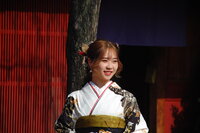
After a "satisfying" lunch of raw fish bits we went off in search of Geishas. Actually, we went to look at the old area of town where this trade used to be plied in spades. Nowadays? Not so much (although it is still somewhat of an ongoing concern). However, the architecture is interesting and archetypal, being mostly wooden buildings that have aged in interesting ways. Many of the buildings are now shops selling tourist tat, of which gold-leaf forms a major part as do cats. We also managed to find the Ninja Museum (not sure what that says), where Megan had a go with the classic throwing stars. Suffice to say, we are not in any ninja-related danger from that quarter! As one would expect when pounding the pavement doing sight-seeing, we have been in quite a few cafés. Luckily, coffee seems to be a staple here. However, when visiting the Shogun house, we chose not to visit the nearby Café Moron.
We only had a couple of days in Kanazawa. It is not a hugely touristy place, but it is still quite busy and bustling. We stayed in the Korinbo district which is home a large variety of up-market shops (think Breitling, Armani, Gucci, Rolex, etc). Consequently, we have not bought any souvenirs! Korinbo is also home to Café Dumbo, which we also chose not to visit. What is it with the Japanese and their café names? On our evening sojourns to find dinner, we observed quite a number of restaurants that had signs outside saying "Please speak Japanese in our shop". Of course, this is a thinly disguised statement that tourists are not welcome. Which is fine because, by extension, we take this to really mean "we serve unidentifiable food you will not like and we don't want bad reviews on Tripadvisor". Happy to oblige!
If the dinosaurs allow it, we are moving on to Kyoto next, a place of which some of you may have heard. After the rather impressive Kagayaki 509, we are next booked on a train called "Thunderbird 18". Which is a rather cool name even if it is a rather lower class train.
We will bring you news from Kyoto later. Hopefully something amusing will occur. As we said before, it's hard to find comedy in such a ruthlessly serious and efficient country. Apologies to our regular readers.
Some Pictures
